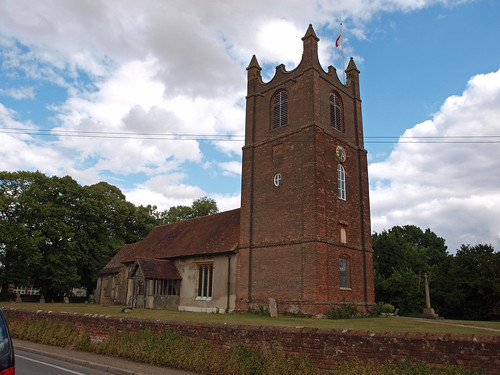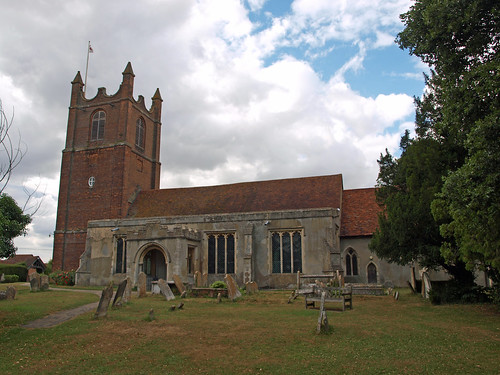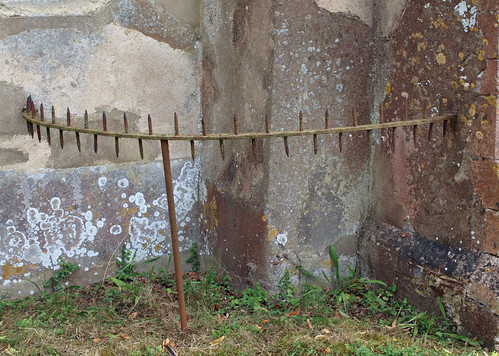The area around St Margaret of Antioch is about as hilly as it gets around these parts and thus the church commands the village and provides some great views. Sadly it was locked with no keyholder listed and the general impression was of dilapidation, general neglect and, nonetheless, genteel decline.
A heavily restored chancel and nave had a brick built tower added in 1699 and the overall effect is definitely a Marmite one - I think I come down on the side of love it....but then again....nope definitely love it. I got the feeling that this church would absolutely deliver on the interior but we'll probably never know as all Google returns show it as locked. I would like to know what the curious iron 'candle' spikes on the exterior north nave wall were for though.
UPDATE: Having been told that keyholders are now listed I revisited on 28/02/13 and, after having received the third degree before the key was released into my care, gained entry. The interior though simple is as lovely as expected; light, airy and spacious - it has a really nice feel to it.
ST MARGARET OF ANTIOCH. W tower of 1699, built of red brick. On the W side together with other names that of the bricklayer, Daniel Hill, is recorded. The tower has arched windows and battlements with obelisk pinnacles. The distinguishing feature is the semicircular troughs between the battlements. The church is of the C14. It has a S aisle with an arcade on octagonal piers, carrying double-chamfered arches. The chancel on its S side has a group of cusped arches, first a low broad recess, then two single sedilia seats and then the piscina. In the recess a low tomb-chest with quatrefoil decoration. The windows are all Perp. - STAINED GLASS. In the S aisle E window small figure of the C15; Coronation of the Virgin and one censing angel. - MONUMENTS. Knight of c.1260, cross-legged with flat-topped pot-helmet, Purbeck marble (below the organ). - Brass to John Cracherod d. 1534 and wife (also below the organ)*. - Dorcas Smyth d. 1633 by John Colt, son of the more famous Maximilian Colt. The monument is a display of emblems, without effigy; beehive for Industria Dulcis, heart for Spes, hand pointing upward for Caritas. Originally there was also a dove for Fides. On the sides open books with their titles now alas mostly illegible.
* The knight effigy is not visible (and probably wasn't when Pevsner wrote this entry) and only half of the Cracherod brass peeks out from under the organ.
UPDATE: Having been told that keyholders are now listed I revisited on 28/02/13 and, after having received the third degree before the key was released into my care, gained entry. The interior though simple is as lovely as expected; light, airy and spacious - it has a really nice feel to it.
ST MARGARET OF ANTIOCH. W tower of 1699, built of red brick. On the W side together with other names that of the bricklayer, Daniel Hill, is recorded. The tower has arched windows and battlements with obelisk pinnacles. The distinguishing feature is the semicircular troughs between the battlements. The church is of the C14. It has a S aisle with an arcade on octagonal piers, carrying double-chamfered arches. The chancel on its S side has a group of cusped arches, first a low broad recess, then two single sedilia seats and then the piscina. In the recess a low tomb-chest with quatrefoil decoration. The windows are all Perp. - STAINED GLASS. In the S aisle E window small figure of the C15; Coronation of the Virgin and one censing angel. - MONUMENTS. Knight of c.1260, cross-legged with flat-topped pot-helmet, Purbeck marble (below the organ). - Brass to John Cracherod d. 1534 and wife (also below the organ)*. - Dorcas Smyth d. 1633 by John Colt, son of the more famous Maximilian Colt. The monument is a display of emblems, without effigy; beehive for Industria Dulcis, heart for Spes, hand pointing upward for Caritas. Originally there was also a dove for Fides. On the sides open books with their titles now alas mostly illegible.
* The knight effigy is not visible (and probably wasn't when Pevsner wrote this entry) and only half of the Cracherod brass peeks out from under the organ.
Simon K -
For one extraordinary moment I thought I had been here before - the approach and the setting are so reminiscent of Great Easton, ten miles or so to the south-west. There are several keys, including one at the shop directly opposite (closes 12.30 on saturday, so I still had time). It is a delightful church inside, I liked it very much, a real feel of the rustic 19th Century, and the weepiest weeping chancel I think I have ever seen! There's medieval glass in the aisle, and a most extraordinary monument, featuring a beehive and a sheep.
Flickr set.




No comments:
Post a Comment